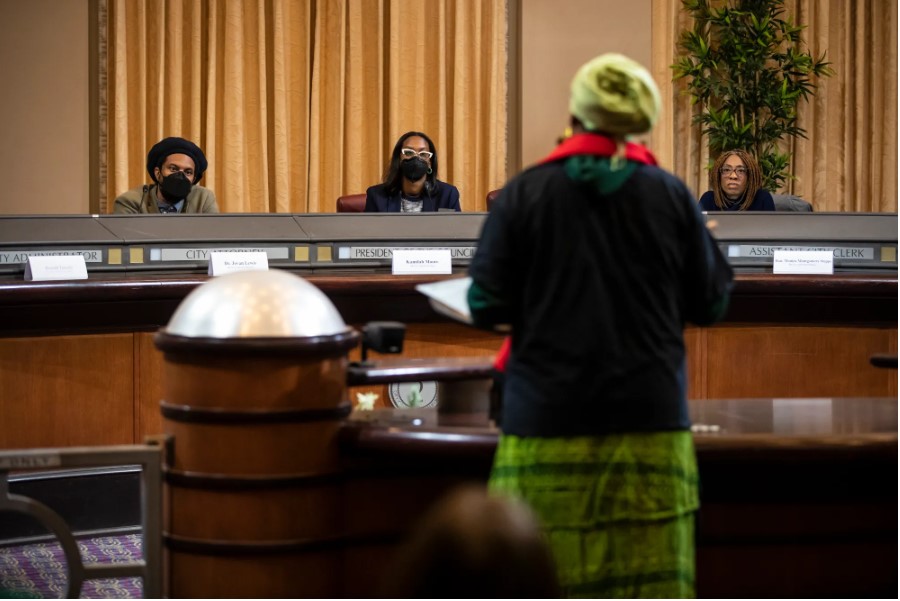The California Reparations Task Force published documents this week indicating it plans to recommend the state apologize for racism and slavery, and consider “down payments” of varying amounts to eligible African American residents.
The documents, numbering more than 500 pages, do not contain an overall price tag for reparations, but they do include ways the state could calculate how much money African Americans in California have lost since the state was established in 1950 because of certain government practices.
The loss calculations would vary depending on type of racial harm and how long a person has lived in California. The loss estimates range from $2,300 per person per year of residence for the over-policing of Black communities to $77,000 total per person for Black-owned business losses and devaluations over the years.
The state-appointed task force faces a July 1 deadline to make reparations recommendations to the Legislature and Gov. Gavin Newsom. Task force leaders have said they expect the Legislature to come up with actual reparations amounts.
The task force is also recommending a variety of policy changes to counteract discrimination.
“It is critical that we compensate, but not just compensate,” said Monica Montgomery Steppe, a San Diego councilmember who is on the task force and spoke at a “listening session” in her city late last week. “We also need to evaluate policy that continues to hold us back.”
Who would get reparations?
The task force documents, which were published on Monday, May 1, discuss two kinds of reparations: those arising from particular instances of discrimination or harm that require an individual to file a claim, and those that involve distributing money or benefits to all eligible Black Californians for racial harm the entire community has experienced.
A recent example of an individual claim was Bruce’s Beach, a beachfront property and resort that Manhattan Beach seized from a Black family nearly 100 years ago. Recently, government leaders returned the land deed to descendants of the Bruce family, who resold it to Los Angeles County for $20 million.
It is one of the few times a Black family was restored property taken by a local government.
Eligibility for reparations continues to be a controversy, however.
The task force in March 2022 voted to limit potential compensation to descendants of free and enslaved Black people who were in the United States in the 19th century. The group narrowly rejected a proposal to include all Black people, including recent immigrants, regardless of lineage.
Everyone in the eligible class should be compensated, the task force report says, even if they can’t prove they suffered a specific harm.
“The State of California created laws and policies discriminating against and subjugating free and enslaved African Americans and their descendants,” the report says. “In doing so, these discriminatory policies made no distinctions between these individuals; the compensatory remedy must do the same.”
The final report, much like the task force’s previous interim report, lays out the history of systemic racism and ongoing injustices in California.
Costs of racial damage
The latest batch of documents also says eligible people should be compensated in cash, sooner rather than later. The records instruct the Legislature to begin with “down payments” that would add up over upcoming years rather than waiting for full loss calculations.
The final report suggests dollar figures for certain categories of racial damage:
- For mass incarceration and the over-policing of Black communities, it estimates a loss per person of $115,260, or $2,352 for each year they lived in California from 1971 to 2020, corresponding to the national War on Drugs.
- For housing discrimination, it offers two methods of loss calculation. One method based on gaps between Black and White “housing wealth” would peg losses at $145,847 per person. The other method, based on governments’ “redlining” history, including discriminatory lending and zoning, would calculate Black residents’ losses at $148,099 per person — or $3,366 for each year they lived in California from 1933 to 1977.
- For injustices and discrimination in health, it estimates $13,619 per person for each year lived in California, or $966,921 total for someone living about 71 years — the average life expectancy of Black residents in California in 2021.
The reparations program would be overseen by a new state agency that would determine eligibility and distribute funds, the report says. The agency woould also be responsible for helping individuals document and provide evidence for specific injustices.
Eligible Black residents should not expect cash payments anytime soon. The state Legislature and Newsom will decide whether any reparations are paid, and it’s unclear what they will do with the task force recommendations.
“This is the time where we really need the voice of the public,” said Khansa T. Jones-Muhammad, also known as Friday Jones, a member of Los Angeles’ reparations advisory commission. “This is the time to get your churches together. This is the time to get your school boards together.”
Jones made the comments during the listening session in San Diego.
Non-cash reparations
Some task force members have been dismayed at the amount of attention paid to the dollar figures under discussion. The final report provides dozens of policy recommendations aimed at preventing further discrimination and harm against Black residents.
“The biggest fight is implementation of all these recommendations, “ Montgomery Steppe said. “After the task force issues its final report, those recommendations need strong support in California’s Legislature and the government. It will take all hands on deck to ensure we push for a policy change from our state Legislature.”
The task force is scheduled to meet again at 9 a.m. Saturday, May 6, at Lisser Hall at Northeastern University, 5000 MacArthur Blvd., in Oakland. The meeting will be live streamed.










